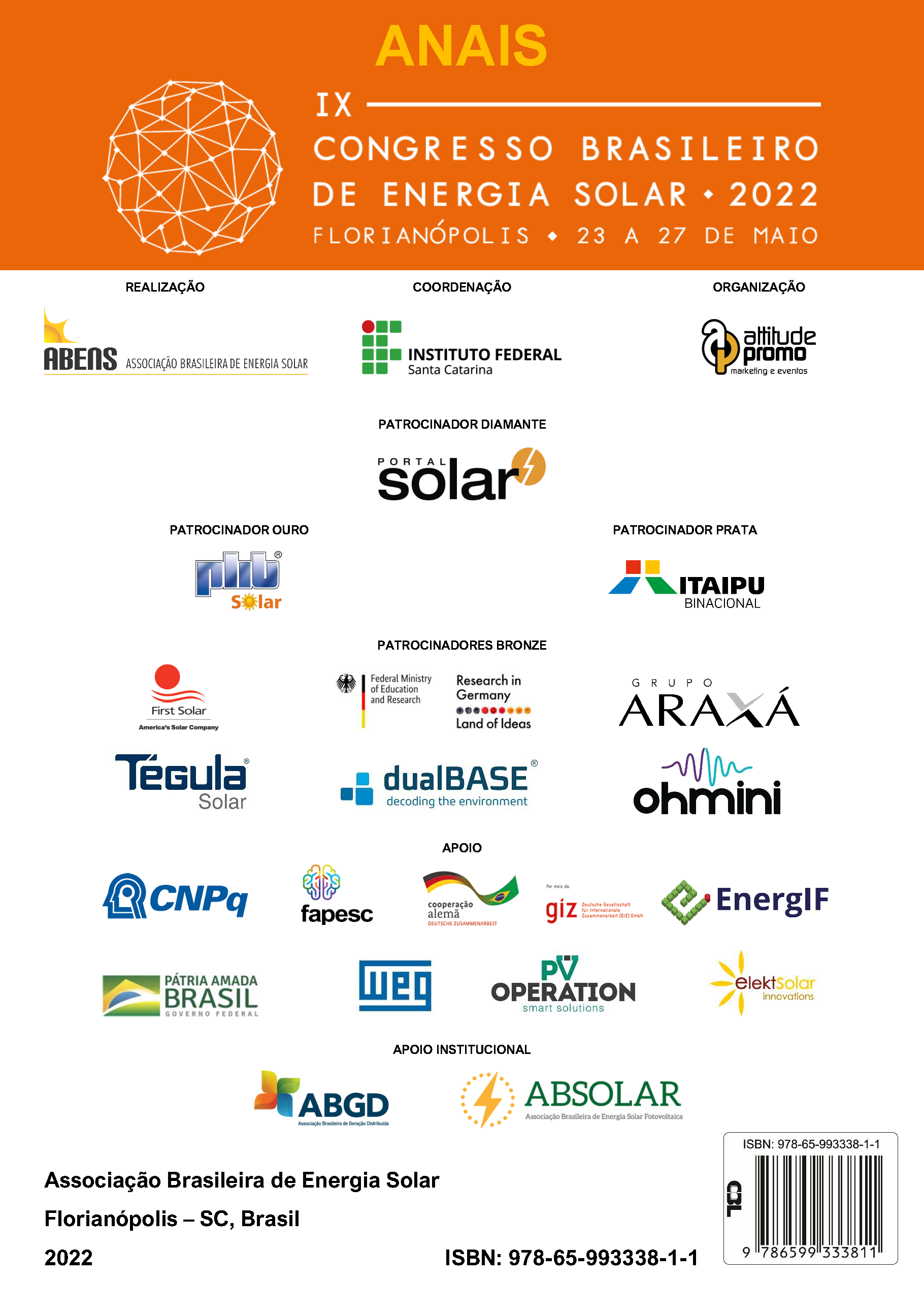CONTRIBUIÇÕES NO ALGORITMO DE RASTREAMENTO DO PONTO DE MÁXIMA POTÊNCIA EM LOCAIS COM GRANDE VARIAÇÃO DE IRRADIÂNCIA
DOI:
https://doi.org/10.59627/cbens.2022.1141Palavras-chave:
Energia solar, Ponto de máxima potência, Controle por modos deslizantesResumo
Um método para o rastreamento do ponto de máxima potência em módulos fotovoltaicos utilizando duas técnicas distintas em paralelo é proposto. Esse método utiliza o algoritmo Perturba e Observa (P&O), que é uma técnica simples e eficiente de rastreamento, trabalhando em paralelo com uma técnica via modo deslizantes, que é uma técnica robusta e de fácil implementação. Para validação da proposta, foi simulado um conversor Boost utilizando o método, e comparado com o mesmo conversor com um método P&O modificado. Os dados de radiação foram obtidos com auxílio de uma estação solarimétrica capaz de aquisitar os dados a cada segundo, que evidencia a grande variação da irradiação durante o dia na cidade de Natal. Os resultados numéricos demostraram que, em comparação com o P&O, o método proposto obtém uma velocidade de rastreamento mais rápida e uma melhor eficiência.
Downloads
Referências
Anoop, K., Nandakumar, M., 2018. A novel maximum power point tracking method based on particle swarm optimization combined with one cycle control, International Conference on Power, Instrumentation, Control and Computing.
Barreto, R. L, 2014. Contribuições ao Método de Rastreamento de Máxima Potência para Sistemas Fotovoltaicos, Dissertação de Mestrado, PPGEEC, UFRN, Natal.
Bianconi, E. et al., 2012. A fast current-based mppt technique employing sliding mode control, IEEE Transactions on Industrial Electronics, vol. 60, n. 3, pp. 1168-1178.
Dantas, S. G., Pompermayer, F. M., 2018. Viabilidade Econômica de Sistemas Fotovoltaicos no Brasil e Possíveis Efeitos no Setor Elétrico, Ipea.
Drissi, H. et al., 2017. Critical factors affecting the photovoltaic characteristic and comparative study between two maximum power point tracking algorithms, International Journal of Hydrogen Energy, vol. 42, n. 13, pp. 8689-8702.
Femia, N. et al., 2017. Predictive & adaptive mppt perturb and observe method, IEEE Transactions on Aerospace and Electronic Systems, vol. 43, n. 3, pp. 934-950.
Femia, N. et al., 2005. Optimization of perturb and observe maximum power point tracking method, IEEE Transactions on Power Electronics, vol. 20, n. 4, pp. 963-973.
Gaur, P., Verma, Y. P.; Singh, P., 2015. Maximum power point tracking algorithms for photovoltaic applications: A comparative study, 2nd International Conference on Recent Advances in Engineering & Computational Sciences.
Ishaque, K. et al., 2012. An improved particle swarm optimization (pso)–based mppt for pv with reduced steady-state oscillation, IEEE Transactions on Power Electronics, vol. 27, n. 8, pp. 3627-3638.
Killi, M., Samanta, S., 2015. Modified perturb and observe mppt algorithm for drift avoidance in photovoltaic systems, IEEE Transactions on Industrial Electronics, vol. 62, n. 9, pp. 5549-5559.
Koehl, M., Hoffmann, S., Wiesmeier, S., 2017. Evaluation of damp-heat testing of photovoltaic modules, Research and Applications, vol. 25, n. 2, pp. 175-183.
Lamzouri, F., Boufounas, E., Amrani, A. E., 2013. A robust backstepping sliding mode control for mppt based photovoltaic system with a dc-dc boost converter, International Conference on Control, Automation and Diagnosis.
Mamarelis, E., Petrone, G., Spagnuolo, G., 2013. Design of a sliding-mode-controlled sepic for pv mppt applications, IEEE Transactions on Industrial Electronics, vol. 61, n. 7, pp. 3387-3398.
Masoum, M. A., Dehbonei, H., 2002. Fuchs, E. F. Theoretical and experimental analyses of photovoltaic systems with voltageand current-based maximum power-point tracking, IEEE Transactions on Energy Conversion, vol. 17, n. 4, pp. 514-522.
Ouberri, Y., Yatimi, H., Aroudam, E., 2020. Design of a robust sliding mode controller for mppt based on automation plc for pv applications, International Transactions on Electrical Energy Systems, vol. 30, n. 4, pp. 1-6.
Pradhan, R., Subudhi, B., 2015. Double integral sliding mode mppt control of a photovoltaic system, IEEE Transactions on Control Systems Technology, vol. 24, n. 1, pp. 285-292.
Saravanan, S., Babu, N. R., 2016. Maximum power point tracking algorithms for photovoltaic system - a review, Renewable and Sustainable Energy Reviews, vol. 57, pp. 192-204.
Slotine, J.-J. E., LI, W. et al., 1991. Applied nonlinear control, Prentice hall Englewood Cliffs.
Udayalakshmi J. K., Mohammed S., 2017. Comparative study of perturbobserve and look -up table maximum power point tracking techniques using matlab/simulink, International Conference on Current Trends toward Converging Technologies, Coimbatore.
Utkin, V., Guldner, J., Shi, J., 2017. Sliding mode control in electro-mechanical systems, CRC press.
Zhang, F. et al., 2015. Novel current sensing photovoltaic maximum power point tracking based on sliding mode control strategy, Solar Energy, vol. 118, pp. 80–86.


